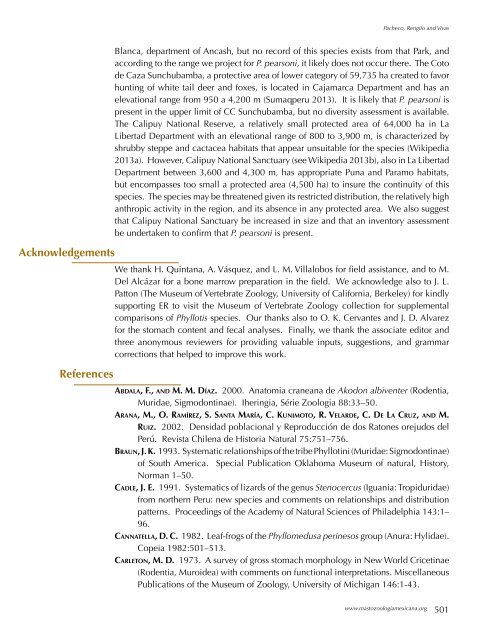therya-5_2
therya-5_2
therya-5_2
You also want an ePaper? Increase the reach of your titles
YUMPU automatically turns print PDFs into web optimized ePapers that Google loves.
Pacheco, Rengifo and Vivas<br />
Acknowledgements<br />
References<br />
Blanca, department of Ancash, but no record of this species exists from that Park, and<br />
according to the range we project for P. pearsoni, it likely does not occur there. The Coto<br />
de Caza Sunchubamba, a protective area of lower category of 59,735 ha created to favor<br />
hunting of white tail deer and foxes, is located in Cajamarca Department and has an<br />
elevational range from 950 a 4,200 m (Sumaqperu 2013). It is likely that P. pearsoni is<br />
present in the upper limit of CC Sunchubamba, but no diversity assessment is available.<br />
The Calipuy National Reserve, a relatively small protected area of 64,000 ha in La<br />
Libertad Department with an elevational range of 800 to 3,900 m, is characterized by<br />
shrubby steppe and cactacea habitats that appear unsuitable for the species (Wikipedia<br />
2013a). However, Calipuy National Sanctuary (see Wikipedia 2013b), also in La Libertad<br />
Department between 3,600 and 4,300 m, has appropriate Puna and Paramo habitats,<br />
but encompasses too small a protected area (4,500 ha) to insure the continuity of this<br />
species. The species may be threatened given its restricted distribution, the relatively high<br />
anthropic activity in the region, and its absence in any protected area. We also suggest<br />
that Calipuy National Sanctuary be increased in size and that an inventory assessment<br />
be undertaken to confirm that P. pearsoni is present.<br />
We thank H. Quintana, A. Vásquez, and L. M. Villalobos for field assistance, and to M.<br />
Del Alcázar for a bone marrow preparation in the field. We acknowledge also to J. L.<br />
Patton (The Museum of Vertebrate Zoology, University of California, Berkeley) for kindly<br />
supporting ER to visit the Museum of Vertebrate Zoology collection for supplemental<br />
comparisons of Phyllotis species. Our thanks also to O. K. Cervantes and J. D. Alvarez<br />
for the stomach content and fecal analyses. Finally, we thank the associate editor and<br />
three anonymous reviewers for providing valuable inputs, suggestions, and grammar<br />
corrections that helped to improve this work.<br />
Abdala, F., and M. M. Díaz. 2000. Anatomia craneana de Akodon albiventer (Rodentia,<br />
Muridae, Sigmodontinae). Iheringia, Série Zoologia 88:33–50.<br />
Arana, M., O. Ramírez, S. Santa María, C. Kunimoto, R. Velarde, C. De La Cruz, and M.<br />
Ruiz. 2002. Densidad poblacional y Reproducción de dos Ratones orejudos del<br />
Perú. Revista Chilena de Historia Natural 75:751–756.<br />
Braun, J. K. 1993. Systematic relationships of the tribe Phyllotini (Muridae: Sigmodontinae)<br />
of South America. Special Publication Oklahoma Museum of natural, History,<br />
Norman 1–50.<br />
Cadle, J. E. 1991. Systematics of lizards of the genus Stenocercus (Iguania: Tropiduridae)<br />
from northern Peru: new species and comments on relationships and distribution<br />
patterns. Proceedings of the Academy of Natural Sciences of Philadelphia 143:1–<br />
96.<br />
Cannatella, D. C. 1982. Leaf-frogs of the Phyllomedusa perinesos group (Anura: Hylidae).<br />
Copeia 1982:501–513.<br />
Carleton, M. D. 1973. A survey of gross stomach morphology in New World Cricetinae<br />
(Rodentia, Muroidea) with comments on functional interpretations. Miscellaneous<br />
Publications of the Museum of Zoology, University of Michigan 146:1-43.<br />
www.mastozoologiamexicana.org<br />
501



